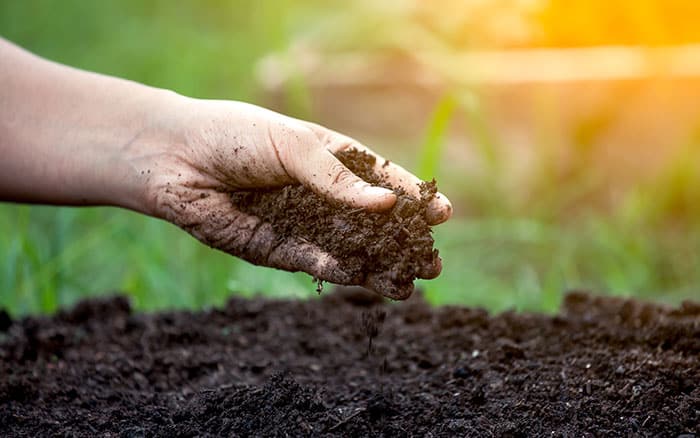Low maintenance gardens often consist of the homeowner laying the whole garden down to paving slabs. If you live in a property with a patio garden, why not consider lifting some of the slabs to make planting pockets of floral delights in your paving.
The overall area will still be low maintenance as the plants are contained within the square of soil revealed when lifting the slab, but you will have the joy of bringing floral life to your garden as well as helping wildlife.
Condition of the soil
There are a few things to be aware of when removing a paving slab. The first is to check the condition of the soil underneath. It might be compacted which can be rectified by digging over with a border fork removing any large stones or rubble and adding organic matter such as well rotted manure.
It may have cement under it. In this case, remove it all plus some of the underlying soil and replace with good quality topsoil.

Soil structure
Assess the structure of soil before choosing plants for the space. This is quite easily done once dug over by picking up a handful of soil and squashing it in one hand. If it binds together, that’s an indication it’s clay based. Clay soil contains lots of nutrients but because the particles are tiny, they tend to stick together making it difficult for plant roots to access the nutrients. The best way to deal with this soil is to add lots of garden compost or other organic matter. Try adding grit to it too.
Choose plants that grow well in clay-based soil such as roses and day lilies.
If the soil doesn’t hold together when squeezed in your hand it’s likely to be sandy. Therefore it has larger soil particles, meaning the soil is well drained but likely to be quite dry.
Examples of plants that need well drained sandy soil are sea holly and lavender. If the plant pocket is in full sun most herbs will grow well too.
The ideal soil type is a combination of clay and sandy. This type benefits plants as it gives plants access to soil nutrients and is also free draining. This means the roots won’t rot in the soil. Therefore you’ll have a much greater choice of plants.

Aspect
The next thing to check before choosing plants is how much sunlight this area of the garden gets. Then, consider if the plant pocket is in a sunny or shady part of the garden.
A rough rule of thumb is plants with silver or silvery grey leaves such as Artemisia (wormwood) ‘Powis Castle’ and Stachys byzantina (lamb’s ear) prefer to grow in full sun in free draining soil.
Plants with dark green and or waxy coated leaves such as Viburnum tinus (laurustinus) and bergenia grow well in shade. However, if in doubt when choosing, read the plant label before buying.

Soil test
Soil is generally classified as being alkaline, neutral, or acidic and most plants prefer to grow in one of those specific types of soil.
Garden centres sell simple kits including soil testers, which give an indication of the soil type which should be kept in mind when choosing plants for the plant pockets.
Generally, if plants are growing in the wrong soil type their leaves will turn shades of yellow and look lacklustre. This is because the roots of the plant are unable to access the soil nutrients.

Types of plants
Next, decide if you want a plant that keeps its leaves year round (evergreen) or sheds all its leaves in autumn (deciduous).
Firstly, the benefits of evergreen plants such as Hebes in full sun and Fatsia japonica for shade, is that they generally look the same year-round. Some have the added advantage of flowering, usually during spring.
On the other hand, if you choose deciduous herbaceous perennials this means you can plant bulbs in the space, such as daffodils, to give you early season interest before the perennial plant springs into life again.
Bear in mind that you can plant a whole host of wonderful perennials, herbs and shrubs in containers that can sit pretty on your patio.


Leave A Comment